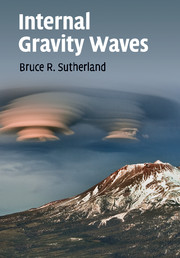1 - Stratified fluids and waves
Published online by Cambridge University Press: 05 October 2014
Summary
Introduction
Outside of theoretical interest in their peculiar properties, one of the main motivations for understanding the dynamics of internal gravity waves is that they occur naturally in the atmosphere and oceans. In the atmosphere, through transporting horizontal momentum from the ground upwards, internal waves influence wind speeds and consequently the thermal structure of the atmosphere. By contrast, internal waves in the ocean are primarily important as they affect mixing through the transport of energy. Although internal waves do not play a dominant role in the evolution of weather and climate, their influence is non-negligible: numerical simulations that do not include the effects of internal waves predict wind speeds and temperature in the atmosphere incorrectly and they do not account for the observed levels of turbulent diffusivity in the oceans. At the mesoscale in the atmosphere internal wave breaking is a source of clear-air turbulence and in the ocean, internal solitary waves influence biological activity over continental shelves through mass transport and mixing.
This chapter begins with a brief introduction to stratified fluids and internal gravity waves and then gives an overview of the structure of the atmosphere and oceans with mention of internal gravity wave phenomena in these fluids. In the following sections, we derive the equations describing the motion and thermodynamics of fluids and then make approximations relevant to internal gravity wave dynamics. The derivations are sometimes heuristic, aiming to provide physical intuition rather than emphasizing rigour.
- Type
- Chapter
- Information
- Internal Gravity Waves , pp. 1 - 73Publisher: Cambridge University PressPrint publication year: 2010



